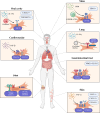The role of fibroblast-neutrophil crosstalk in the pathogenesis of inflammatory diseases: a multi-tissue perspective
- PMID: 40486514
- PMCID: PMC12140995
- DOI: 10.3389/fimmu.2025.1588667
The role of fibroblast-neutrophil crosstalk in the pathogenesis of inflammatory diseases: a multi-tissue perspective
Abstract
Neutrophil-fibroblast crosstalk drives inflammatory pathology across organ systems through both shared and tissue-specific mechanisms. This review synthesizes evidence from skin, lung, gut, cardiovascular, joint, sinus, and oral diseases, revealing conserved molecular pathways where fibroblasts secrete chemokines (CXCL1/8/12) to recruit neutrophils, which, in turn, release neutrophil extracellular traps (NETs), elastase, and cytokines to modulate fibroblast function. Additionally, we identify critical tissue-specific differences, including the predominance of IL-36 signaling in COPD, IL-17-carrying NETs in systemic lupus erythematosus (SLE) and pulmonary fibrosis, and specialized fibroblast subpopulations, such as IDO1+ cells in CRSwNP and TNFRSF21+ cells in periodontitis. Translational insights highlight the therapeutic potential of targeting IL-17, NETs, and fibroblast subpopulations, though tissue-specific risks necessitate precision strategies. Future therapeutic efforts should focus on developing precision-targeted interventions that address organ-specific mechanisms to overcome treatment resistance in inflammatory disorders.
Keywords: NETs; chemokines; cytokines; fibroblasts; inflammation; neutrophils.
Copyright © 2025 Cai, Guan, Wang, Hu, Ou and Jiang.
Conflict of interest statement
The authors declare that the research was conducted in the absence of any commercial or financial relationships that could be construed as a potential conflict of interest.
Figures


Similar articles
-
IL-1β mediated fibroblast-neutrophil crosstalk promotes inflammatory environment in skin lesions of SLE.Clin Immunol. 2024 Dec;269:110396. doi: 10.1016/j.clim.2024.110396. Epub 2024 Nov 8. Clin Immunol. 2024. PMID: 39522851
-
Neutrophil-fibroblast crosstalk drives immunofibrosis in Crohn's disease through IFNα pathway.Front Immunol. 2024 Sep 13;15:1447608. doi: 10.3389/fimmu.2024.1447608. eCollection 2024. Front Immunol. 2024. PMID: 39346917 Free PMC article.
-
Neutrophils-Important Communicators in Systemic Lupus Erythematosus and Antiphospholipid Syndrome.Front Immunol. 2019 Nov 22;10:2734. doi: 10.3389/fimmu.2019.02734. eCollection 2019. Front Immunol. 2019. PMID: 31824510 Free PMC article. Review.
-
REDD1/autophagy pathway promotes thromboinflammation and fibrosis in human systemic lupus erythematosus (SLE) through NETs decorated with tissue factor (TF) and interleukin-17A (IL-17A).Ann Rheum Dis. 2019 Feb;78(2):238-248. doi: 10.1136/annrheumdis-2018-213181. Epub 2018 Dec 18. Ann Rheum Dis. 2019. PMID: 30563869 Free PMC article.
-
Neutrophils in the Pathogenesis of Rheumatoid Arthritis and Systemic Lupus Erythematosus: Same Foe Different M.O.Front Immunol. 2021 Mar 4;12:649693. doi: 10.3389/fimmu.2021.649693. eCollection 2021. Front Immunol. 2021. PMID: 33746988 Free PMC article. Review.
Cited by
-
Neutrophils and NETs in Pathophysiology and Treatment of Inflammatory Bowel Disease.Int J Mol Sci. 2025 Jul 23;26(15):7098. doi: 10.3390/ijms26157098. Int J Mol Sci. 2025. PMID: 40806230 Free PMC article. Review.
References
-
- Balakumar A, Das D, Datta A, Mishra A, Bryak G, Ganesh SM, et al. . Single-cell transcriptomics unveils skin cell specific antifungal immune responses and IL-1Ra-IL-1R immune evasion strategies of emerging fungal pathogen Candida auris. PloS Pathog. (2024) 20:e1012699. doi: 10.1371/journal.ppat.1012699 - DOI - PMC - PubMed
Publication types
MeSH terms
LinkOut - more resources
Full Text Sources
Research Materials

